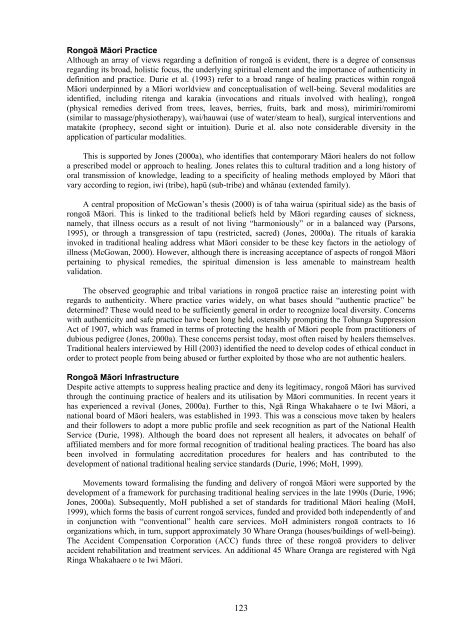traditional knowledge conference 2008 te tatau pounamu
traditional knowledge conference 2008 te tatau pounamu
traditional knowledge conference 2008 te tatau pounamu
Create successful ePaper yourself
Turn your PDF publications into a flip-book with our unique Google optimized e-Paper software.
Rongoā Māori PracticeAlthough an array of views regarding a definition of rongoā is evident, there is a degree of consensusregarding its broad, holistic focus, the underlying spiritual element and the importance of authenticity indefinition and practice. Durie et al. (1993) refer to a broad range of healing practices within rongoāMāori underpinned by a Māori worldview and conceptualisation of well-being. Several modalities areidentified, including ri<strong>te</strong>nga and karakia (invocations and rituals involved with healing), rongoā(physical remedies derived from trees, leaves, berries, fruits, bark and moss), mirimiri/romiromi(similar to massage/physiotherapy), wai/hauwai (use of wa<strong>te</strong>r/s<strong>te</strong>am to heal), surgical in<strong>te</strong>rventions andmataki<strong>te</strong> (prophecy, second sight or intuition). Durie et al. also no<strong>te</strong> considerable diversity in theapplication of particular modalities.This is suppor<strong>te</strong>d by Jones (2000a), who identifies that con<strong>te</strong>mporary Māori healers do not followa prescribed model or approach to healing. Jones rela<strong>te</strong>s this to cultural tradition and a long history oforal transmission of <strong>knowledge</strong>, leading to a specificity of healing methods employed by Māori thatvary according to region, iwi (tribe), hapū (sub-tribe) and whānau (ex<strong>te</strong>nded family).A central proposition of McGowan’s thesis (2000) is of taha wairua (spiritual side) as the basis ofrongoā Māori. This is linked to the <strong>traditional</strong> beliefs held by Māori regarding causes of sickness,namely, that illness occurs as a result of not living “harmoniously” or in a balanced way (Parsons,1995), or through a transgression of tapu (restric<strong>te</strong>d, sacred) (Jones, 2000a). The rituals of karakiainvoked in <strong>traditional</strong> healing address what Māori consider to be these key factors in the aetiology ofillness (McGowan, 2000). However, although there is increasing acceptance of aspects of rongoā Māoripertaining to physical remedies, the spiritual dimension is less amenable to mainstream healthvalidation.The observed geographic and tribal variations in rongoā practice raise an in<strong>te</strong>resting point withregards to authenticity. Where practice varies widely, on what bases should “authentic practice” bede<strong>te</strong>rmined? These would need to be sufficiently general in order to recognize local diversity. Concernswith authenticity and safe practice have been long held, os<strong>te</strong>nsibly prompting the Tohunga SuppressionAct of 1907, which was framed in <strong>te</strong>rms of pro<strong>te</strong>cting the health of Māori people from practitioners ofdubious pedigree (Jones, 2000a). These concerns persist today, most of<strong>te</strong>n raised by healers themselves.Traditional healers in<strong>te</strong>rviewed by Hill (2003) identified the need to develop codes of ethical conduct inorder to pro<strong>te</strong>ct people from being abused or further exploi<strong>te</strong>d by those who are not authentic healers.Rongoā Māori InfrastructureDespi<strong>te</strong> active at<strong>te</strong>mpts to suppress healing practice and deny its legitimacy, rongoā Māori has survivedthrough the continuing practice of healers and its utilisation by Māori communities. In recent years ithas experienced a revival (Jones, 2000a). Further to this, Ngā Ringa Whakahaere o <strong>te</strong> Iwi Māori, anational board of Māori healers, was established in 1993. This was a conscious move taken by healersand their followers to adopt a more public profile and seek recognition as part of the National HealthService (Durie, 1998). Although the board does not represent all healers, it advoca<strong>te</strong>s on behalf ofaffilia<strong>te</strong>d members and for more formal recognition of <strong>traditional</strong> healing practices. The board has alsobeen involved in formulating accreditation procedures for healers and has contribu<strong>te</strong>d to thedevelopment of national <strong>traditional</strong> healing service standards (Durie, 1996; MoH, 1999).Movements toward formalising the funding and delivery of rongoā Māori were suppor<strong>te</strong>d by thedevelopment of a framework for purchasing <strong>traditional</strong> healing services in the la<strong>te</strong> 1990s (Durie, 1996;Jones, 2000a). Subsequently, MoH published a set of standards for <strong>traditional</strong> Māori healing (MoH,1999), which forms the basis of current rongoā services, funded and provided both independently of andin conjunction with “conventional” health care services. MoH adminis<strong>te</strong>rs rongoā contracts to 16organizations which, in turn, support approxima<strong>te</strong>ly 30 Whare Oranga (houses/buildings of well-being).The Accident Compensation Corporation (ACC) funds three of these rongoā providers to deliveraccident rehabilitation and treatment services. An additional 45 Whare Oranga are regis<strong>te</strong>red with NgāRinga Whakahaere o <strong>te</strong> Iwi Māori.123
















